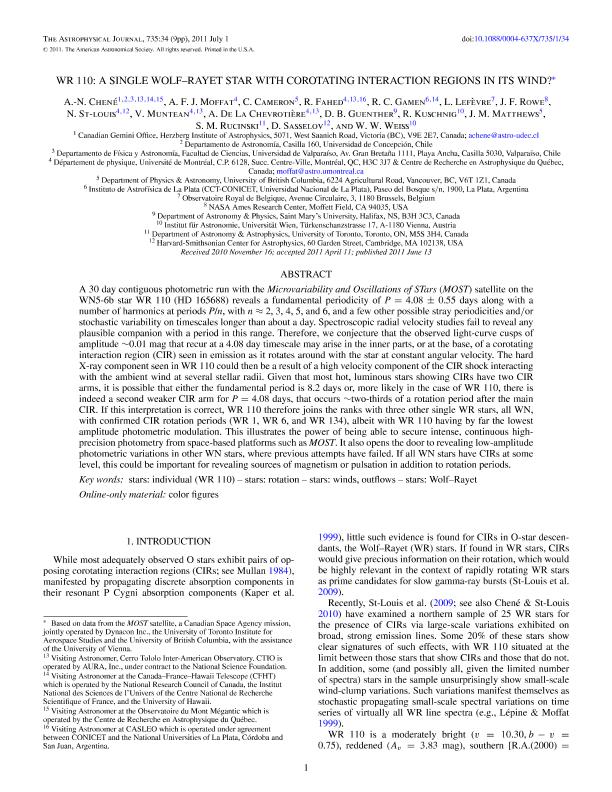Mostrar el registro sencillo del ítem
dc.contributor.author
Chené, A. N.
dc.contributor.author
Moffat, A. F. J.
dc.contributor.author
Cameron, C.
dc.contributor.author
Fahed, R.
dc.contributor.author
Gamen, Roberto Claudio

dc.contributor.author
Lefevre, L.
dc.contributor.author
Rowe, J. F.
dc.contributor.author
St louis, N.
dc.contributor.author
Muntean, V.
dc.contributor.author
de la Chevrotiere, A.
dc.contributor.author
Guenther, D. B.
dc.contributor.author
Kuschnig, R.
dc.contributor.author
Matthews, J. M.
dc.contributor.author
Rucinski, S. M.
dc.contributor.author
Sasselov, D.
dc.contributor.author
Weiss, W. W.
dc.date.available
2016-12-26T15:31:49Z
dc.date.issued
2011-07
dc.identifier.citation
Chené, A. N.; Moffat, A. F. J.; Cameron, C.; Fahed, R.; Gamen, Roberto Claudio; et al.; WR 110: a single Wolf-Rayet Star with corotating interaction regions in its wind?; Iop Publishing; Astrophysical Journal; 735; 7-2011; 34-43
dc.identifier.issn
0004-637X
dc.identifier.uri
http://hdl.handle.net/11336/10090
dc.description.abstract
A 30 day contiguous photometric run with the Microvariability and Oscillations of STars (MOST) satellite on the WN5-6b star WR 110 (HD 165688) reveals a fundamental periodicity of P = 4.08 ± 0.55 days along with a number of harmonics at periods P/n, with n ≈ 2, 3, 4, 5, and 6, and a few other possible stray periodicities and/or stochastic variability on timescales longer than about a day. Spectroscopic radial velocity studies fail to reveal any plausible companion with a period in this range. Therefore, we conjecture that the observed light-curve cusps of amplitude ~0.01 mag that recur at a 4.08 day timescale may arise in the inner parts, or at the base, of a corotating interaction region (CIR) seen in emission as it rotates around with the star at constant angular velocity. The hard X-ray component seen in WR 110 could then be a result of a high velocity component of the CIR shock interacting with the ambient wind at several stellar radii. Given that most hot, luminous stars showing CIRs have two CIR arms, it is possible that either the fundamental period is 8.2 days or, more likely in the case of WR 110, there is indeed a second weaker CIR arm for P = 4.08 days, that occurs ~two-thirds of a rotation period after the main CIR. If this interpretation is correct, WR 110 therefore joins the ranks with three other single WR stars, all WN, with confirmed CIR rotation periods (WR 1, WR 6, and WR 134), albeit with WR 110 having by far the lowest amplitude photometric modulation. This illustrates the power of being able to secure intense, continuous high-precision photometry from space-based platforms such as MOST. It also opens the door to revealing low-amplitude photometric variations in other WN stars, where previous attempts have failed. If all WN stars have CIRs at some level, this could be important for revealing sources of magnetism or pulsation in addition to rotation periods.
dc.format
application/pdf
dc.language.iso
eng
dc.publisher
Iop Publishing

dc.rights
info:eu-repo/semantics/openAccess
dc.rights.uri
https://creativecommons.org/licenses/by-nc-sa/2.5/ar/
dc.subject
Wr 110 (Estrella)
dc.subject
Rotation of Stars
dc.subject
Star Winds
dc.subject
Wolf-Rayet Stars
dc.subject
Outflows
dc.subject.classification
Astronomía

dc.subject.classification
Ciencias Físicas

dc.subject.classification
CIENCIAS NATURALES Y EXACTAS

dc.title
WR 110: a single Wolf-Rayet Star with corotating interaction regions in its wind?
dc.type
info:eu-repo/semantics/article
dc.type
info:ar-repo/semantics/artículo
dc.type
info:eu-repo/semantics/publishedVersion
dc.date.updated
2016-12-14T12:55:40Z
dc.journal.volume
735
dc.journal.pagination
34-43
dc.journal.pais
Estados Unidos

dc.description.fil
Fil: Chené, A. N.. Universidad de Concepción; Chile
dc.description.fil
Fil: Moffat, A. F. J.. University Of Montreal; Canadá
dc.description.fil
Fil: Cameron, C.. University Of British Columbia; Canadá
dc.description.fil
Fil: Fahed, R.. University Of Montreal; Canadá
dc.description.fil
Fil: Gamen, Roberto Claudio. Consejo Nacional de Investigaciones Científicas y Técnicas. Centro Científico Tecnológico la Plata. Instituto de Astrofísica de la Plata; Argentina
dc.description.fil
Fil: Lefevre, L.. Observatoire Royal de Belgique; Bélgica
dc.description.fil
Fil: Rowe, J. F.. NASA Ames Research Center; Estados Unidos
dc.description.fil
Fil: St louis, N.. University Of Montreal; Canadá
dc.description.fil
Fil: Muntean, V.. University Of Montreal; Canadá
dc.description.fil
Fil: de la Chevrotiere, A.. University Of Montreal; Canadá
dc.description.fil
Fil: Guenther, D. B.. Saint Mary’s University. Department of Astronomy & Physics; Canadá
dc.description.fil
Fil: Kuschnig, R.. University of Toronto. Department of Astronomy & Astrophysics; Canadá
dc.description.fil
Fil: Matthews, J. M.. University of British Columbia. Department of Physics & Astronomy; Estados Unidos
dc.description.fil
Fil: Rucinski, S. M.. University of Toronto. Department of Astronomy & Astrophysics; Canadá
dc.description.fil
Fil: Sasselov, D.. Harvard-Smithsonian Center for Astrophysics; Estados Unidos
dc.description.fil
Fil: Weiss, W. W.. Technische Universitat Wien; Austria
dc.journal.title
Astrophysical Journal

dc.relation.alternativeid
info:eu-repo/semantics/altIdentifier/arxiv/http://dx.doi.org/10.1088/0004-637X/735/1/34
dc.relation.alternativeid
info:eu-repo/semantics/altIdentifier/url/http://iopscience.iop.org/article/10.1088/0004-637X/735/1/34/meta
Archivos asociados
